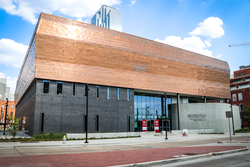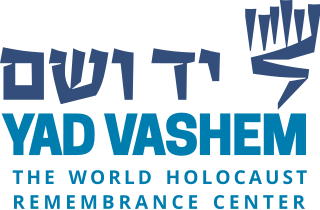
Yad Vashem is Israel's official memorial to the victims of the Holocaust. It is dedicated to preserving the memory of the Jews who were murdered; echoing the stories of the survivors; honoring Jews who fought against their Nazi oppressors and gentiles who selflessly aided Jews in need; and researching the phenomenon of the Holocaust in particular and genocide in general, with the aim of avoiding such events in the future. Yad Vashem's vision, as stated on its website, is: "To lead the documentation, research, education and commemoration of the Holocaust, and to convey the chronicles of this singular Jewish and human event to every person in Israel, to the Jewish people, and to every significant and relevant audience worldwide."

The United States Holocaust Memorial Museum (USHMM) is the United States' official memorial to the Holocaust. Adjacent to the National Mall in Washington, D.C., the USHMM provides for the documentation, study, and interpretation of Holocaust history. It is dedicated to helping leaders and citizens of the world confront hatred, prevent genocide, promote human dignity, and strengthen democracy.

The Museum of Tolerance (MOT), also known as Beit HaShoah, is a multimedia museum in Los Angeles, California, United States, designed to examine racism and prejudice around the world with a strong focus on the history of the Holocaust. The museum was established in 1993, as the educational arm of human rights organization, the Simon Wiesenthal Center. The museum also deals with atrocities in Cambodia and Latin America, along with issues like bullying and hate crimes. The museum has an associated museum and professional development multi-media training facility in New York City.

The Austrian Service Abroad is a non-profit organization funded by the Austrian government which sends young Austrians to work in partner institutions worldwide serving Holocaust commemoration in form of the Gedenkdienst, supporting vulnerable social groups and sustainability initiatives in form of the Austrian Social Service and realizing projects of peace within the framework of the Austrian Peace Service. The Austrian Service Abroad is the issuer of the annually conferred Austrian Holocaust Memorial Award.

The Virginia Holocaust Museum (VHM) is a public history museum located in Richmond, Virginia, United States. The museum is dedicated to depicting the Holocaust through the personal stories of its victims.

The Montreal Holocaust Museum is a museum located in Montreal, Quebec, Canada. It is dedicated to educating people of all ages and backgrounds about the Holocaust, while sensitizing the public to the universal perils of antisemitism, racism, hate and indifference. Through the museum, its commemorative programs and educational initiatives, it aims to promote respect for diversity and the sanctity of human life. The Museum was founded in 1979 as the Montreal Holocaust Memorial Centre and is Canada's first and only recognized Holocaust museum.

The Holocaust Museum Houston is located in Houston's Museum District, in Texas. It is the fourth largest holocaust museum in the U.S. It was opened in 1996.
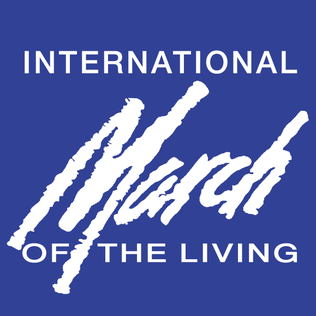
The March of the Living is an annual educational program which brings students from around the world to Poland, where they explore the remnants of the Holocaust. On Holocaust Memorial Day observed in the Jewish calendar, thousands of participants march silently from Auschwitz to Birkenau.
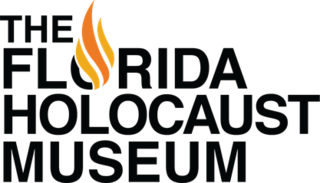
The Florida Holocaust Museum is a Holocaust museum located at 55 Fifth Street South in St. Petersburg, Florida. Founded in 1992, it moved to its current location in 1998. Formerly known as the Holocaust Center, the museum officially changed to its current name in 1999. It is one of the largest Holocaust museums in the United States. It was founded by Walter and Edith Lobenberg both of whom were German Jews who escaped persecution in Nazi Germany by immigrating to the United States. Holocaust survivor Elie Wiesel served as Honorary Chairman and cut the ribbon at the 1998 opening ceremony. The Florida Holocaust Museum is one of three Holocaust Museums that are accredited by the American Alliance of Museums. The museum works with the local community and survivors of the Holocaust to spread awareness and to educate the public on the history of the Holocaust.

The International Holocaust Remembrance Day, or the International Day in Memory of the Victims of the Holocaust, is an international memorial day on 27 January that commemorates the victims of the Holocaust, which resulted in the genocide of one third of the Jewish people, along with countless members of other minorities by Nazi Germany between 1933 and 1945, an attempt to implement its "final solution" to the Jewish question. 27 January was chosen to commemorate the date when the Auschwitz concentration camp was liberated by the Red Army in 1945.
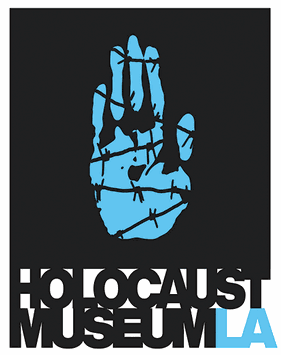
Holocaust Museum LA, formerly known as Los Angeles Museum of the Holocaust, is a museum located in Pan Pacific Park within the Fairfax district of Los Angeles, California. Founded in 1961 by Holocaust survivors, Holocaust Museum LA is the oldest museum of its kind in the United States. Its mission is to commemorate those murdered in the Holocaust, honor those who survived, educate about the Holocaust, and inspire a more dignified and humane world.

The Illinois Holocaust Museum and Education Center is a museum located in Skokie, Illinois, near Chicago. According to the Center's mission statement, its founding principle is to "Remember the Past; Transform the Future." Its mission is to preserve the legacy of the Holocaust by honoring victims' memories and to educate in the service of combating hatred, prejudice, and indifference. The Museum fulfills its mission through its collections-based exhibitions and through education programs and other initiatives that promote human rights and the elimination of genocide.
Holocaust studies, or sometimes Holocaust research, is a scholarly discipline that encompasses the historical research and study of the Holocaust. Institutions dedicated to Holocaust research investigate the multidisciplinary and interdisciplinary aspects of Holocaust methodology, demography, sociology, and psychology. It also covers the study of Nazi Germany, World War II, Jewish history, antisemitism, religion, Christian-Jewish relations, Holocaust theology, ethics, social responsibility, and genocide on a global scale. Exploring trauma, memories, and testimonies of the experiences of Holocaust survivors, human rights, international relations, Jewish life, Judaism, and Jewish identity in the post-Holocaust world are also covered in this type of research.
USC Shoah Foundation – The Institute for Visual History and Education, formerly Survivors of the Shoah Visual History Foundation, is a nonprofit organization dedicated to making audio-visual interviews with survivors and witnesses of the Holocaust a compelling voice for education and action. It was established by Steven Spielberg in 1994, one year after completing his Academy Award-winning film Schindler's List. In January 2006, the foundation partnered with and relocated to the University of Southern California (USC) and was renamed the USC Shoah Foundation – The Institute for Visual History and Education. In March 2019, the institute opened their new global headquarters on USC's campus.

The Cape Town Holocaust & Genocide Centre began as Africa's first Holocaust centre founded in 1999. It has sister Centres in Johannesburg and Durban, and together they form part of the association, the South African Holocaust & Genocide Foundation (SAHGF). The SAHGF determines the educational and philosophical direction of the centre. It also conducts teacher training and is the only accredited service-provider for in-service training in Holocaust education in the country. It has trained over 5,000 teachers.

Witness: Passing the Torch of Holocaust Memory to New Generations is a large format volume, published by Canadian Second Story Press, inspired by a 2014 United Nations exhibit of reflections and images of Holocaust survivors and students who have traveled on the March of the Living since 1988. The exhibit and the book are intended to educate a new generation of students about the atrocities of the Second World War. In collaboration with March of the Living, an organization that spearheads visits to the Polish grounds where Nazi atrocities occurred, Toronto religious leader and Holocaust educator Eli Rubenstein compiled this book which includes an introduction from Pope Francis.
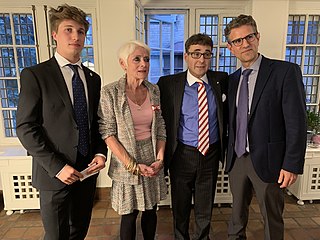
Naomi Kramer is a Canadian curator and president of the Holocaust Education and Genocide Prevention Foundation.
Dimensions in Testimony is a collection of 3D interactive genocide survivor testimonies, produced by USC Shoah Foundation in order to preserve the conversational experience of asking survivors questions about their life and hearing responses in real time, therefore preserving history through first-person narrative.
Max Glauben was a Polish-born American educator, community organizer, writer, and Holocaust survivor.

